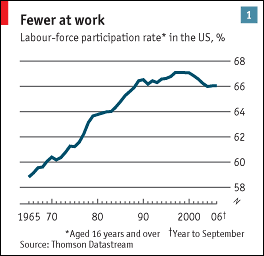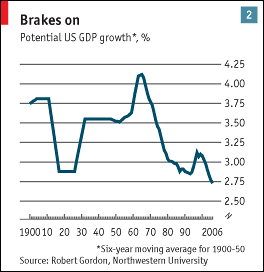Slow road ahead / economist
fantastic summary why the best times for the us economy as a powerhouse are at least for the next few year are over
America's long-term potential rate of growth is falling, perhaps to its lowest pace in over a century
http://www.economist.com/business/displaystory.cfm?story_id=8079134

EVERYONE knows that America's economy is slowing. Thanks to the bursting of the housing bubble, overall GDP growth has fallen back sharply. The biggest short-term uncertainty for the world economy is whether American consumers stop spending and drag the country into recession. But beyond the business cycle, another slowdown has received scant attention. America's potential rate of growth—that is, the pace at which annual output can expand without pushing up inflation—is also falling. By some estimates, it could drop to 2.5% over the next few years, which would be the slowest pace in over a century.
If that happens, the consequences will be serious. Tax revenues will grow more slowly than expected. Monetary policy will become harder to manage: as the 1970s showed, inflation can get out of control if central bankers do not realise that an economy's speed limit has fallen. Financial markets will be disturbed as conventional wisdom adjusts from an assumption of 3-3.5% potential output growth, and investors downgrade their expectations. (i bet that some spinning will be at works/gehe jede wette ein das neue statistiken adjustiert werden um dinge besser aussehen zu lassen)

Potential output is hard to estimate, let alone predict......Over the long run economic growth depends on two things: increases in the supply and productivity of labour. The growth of labour supply, in turn, depends on the growth of the working-age population, the proportion of people who work and the number of hours they put in. The pace of productivity growth depends on capital investment, improvements in business processes and technological innovation.....
.... this kind of “growth accounting” is fraught with difficulty. Both labour supply and productivity growth bounce around during business cycles. ........ Productivity growth is usually higher at the beginning of an expansion than at its end as firms work their existing employees harder before hiring new people. As a result, potential output can temporarily diverge from its underlying trends, making it even harder to estimate.
....... After the 2001 recession, productivity growth accelerated again, while the growth of labour supply slowed sharply. The share of working-age Americans in jobs fell after rising almost continuously for over four decades (see chart 1). This fall was widely interpreted as temporary, a sign that the recession was deeper than it appeared. But after five years of expansion, it has not been reversed, suggesting (although the evidence is still tentative) that structural changes are afoot. These labour-markets shifts are the main reason to be pessimistic about America's potential output growth. 
So why is the proportion of Americans who work falling? For three reasons.
First, the baby-boomers are heading towards retirement. The share of people aged between 55 and 64 has risen from 10.5% in 1995 to 13.3% in 2005 and is likely to reach over 16% by 2015. People over 55 tend to work much less than younger folk.
Second, the rush of women into the workplace has stopped. The proportion of women working rose from below 40% in 1960 to a peak of over 60% in 1999. It has subsequently fallen slightly.
Third, the rate of teenage employment has plunged. In the 1990s over 50% of young people aged 16-19 had jobs. Today just over 40% do, the biggest drop since records began. This decline is a bit of a mystery, since job growth in the kinds of industries that tend to employ young people—restaurants and shops—has been well above the national average. It may have happened because teenagers are staying at school or college longer, and are working less on the side. More education may mean higher future productivity, but in the medium term it cuts the number of available workers.(lets hope that they all can get a job that is close to thier education (offshoring etc)/ man kann nur hoffen das all die studierten auch in den usa einen angemessenen job finden und nicht mehr outgesourced wird....) http://immobilienblasen.blogspot.com/2006/10/mother-of-all-revisions-mutter-aller.html
..... America's trend rate of labour-force participation could drop by a further 1.4 percentage points in the next four years, to just over 64%. ..... By 2010, the Fed economists reckon, labour supply in America will be rising by a mere 0.4% a year, well under half its current rate.
The geezer difference
These projections could be too gloomy..... An unexpected jump in what Dick Berner of Morgan Stanley calls the “geezer labour force” could make a difference as ageing baby-boomers work longer. Men in their 60s are already the fastest-growing segment of the workforce, although this has not made up for the overall decline. ( i bet that the main reason is that their retierementfundings are not sufficient....../liegt wohl an erster linie das ihre rentenvosrorge zu niedrig ist.....)
A rise in immigration could increase the supply of labour, too, particularly since the proportion of immigrants who work is higher than that of native-born Americans. .....
It seems very likely, then, that America's labour supply will grow more slowly. And if that happens, potential output growth will too, unless productivity growth accelerates.
Unfortunately, the latest evidence suggests that, if anything, productivity growth is slowing unexpectedly. Over the past two years, in the non-farm business sector, it slowed to an annual average of 2% from an average of almost 4% in the previous three years. /50%!
And even that figure may be too high. The Bureau of Labour Statistics recently said 810,000 more jobs were created between March 2005 and March 2006 than they first thought. Thanks to those extra jobs the productivity figures for 2005 may be revised down by a further half of a percentage point. For the economy as a whole, the figure is some 0.3-0.5 percentage points lower than the official productivity figures suggest, because productivity growth in farming and government, which are left out of those figures, is even lower.
The longer the economy's expansion goes on, the slower productivity growth is bound to be. But the pace of the deceleration has begun to raise concerns. ......over 60% of the late 1990s productivity surge was related to information technology. .....
The 2001-04 productivity surge is now the focus of an argument with big implications. Only 30% of that acceleration was related to IT, ....
the post-2001 acceleration was the result of cost-cutting, not innovation. Other economists note that the pace of investment, particularly in IT, is much lower than it was in the 1990s. JPMorgan's calculations, for instance, show that firms' spending on IT equipment has grown by only 5.5% a year in this expansionary period, compared with over 20% a year in the late 1990s. Lower capital spending, they fear, could be a harbinger of slower productivity growth. . worries that high oil prices may also have hurt underlying productivity growth,.....
Mr Gordon sees the underlying rate of business productivity growth slowing to below 2.5% which, by his calculations, implies a rate of 2.1% for the overall economy. Coupled with the slowdown in labour supply, he concludes that America's potential growth rate could fall to 2.5%. ....
Mr Gordon's calculations suggest that 2.5% would be America's slowest economic speed limit in over a century (see chart 2).

Since no one foresaw the productivity revolution of the mid-1990s, these predictions could prove too pessimistic. The next “killer application” could be just around the corner. Even without rapid investment, the IT revolution may yield more productivity gains. But without some such happy chance, it looks as though America's potential growth rate is heading for a slowdown, at least for the next few years.
The sooner that investors and policymakers wake up to this, the smoother the adjustment is likely to be.
![[Most Recent Quotes from www.kitco.com]](http://www.kitconet.com/charts/metals/gold/t24_au_en_usoz_2.gif)
![[Most Recent Quotes from www.kitco.com]](http://www.kitconet.com/charts/metals/gold/t24_au_en_euoz_2.gif)

0 Comments:
Post a Comment
<< Home